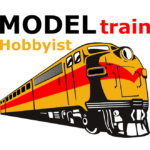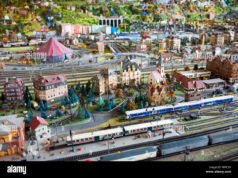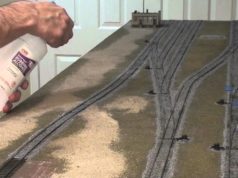Joshua Lionel Cohen was born the eighth of nine children to an immigrant family that came to New York shortly after the Civil War. It is said that he built his first toy train at the age of seven.
Lionel often gave his date of birth as 1880, but the official birth date was three years before that.
The Golden Spike Unification
The Golden Spike that united the Central Pacific and the Union Pacific railroads occurred in 1869, just eight years before Lionel was born. This signaled a high interest in trains that continued into the twentieth century. Trains were a major form of transportation in Lionel’s early years.
Joshua Lionel Cohen – Inventor & Salesman
Lionel dropped out of college to pursue a career as an inventor. His first invention was the flash-lamp that was used for photography. He went into business with Harry C. Grant in 1900, and they concentrated on lighting and fan type novelty items. The motor that ran the first model train was actually designed for a fan.
Better at salesmanship than inventing, in 1900 Lionel convinced a toy store owner that a model train set in his display window would draw people to come and shop. It occurred to Lionel that he could easily make the train operate with his motor and a battery on a brass track.
The storekeeper bought the idea, and shoppers as predicted flocked into the store and wanted a train like the one in the display window, so Lionel was in the model train business from that point on.
At some point, Lionel changed his last name from Cohen to Cowen to hide the fact that he was Jewish. At the turn of the twentieth century, there were many people who did not like Jews, so it was more of a safety issue than one of shame.
Ives Toys Goes Into Receivership
Ives Toys had been the largest toy maker in the world in the nineteenth century, but started to decline by the time that Lionel Trains came into existence. There wasn’t a lot of love between Cowen and Harry Ives, the owner of the rival toy company. As Lionel’s stock was going up, Ives’ was going down. Diversification didn’t help much, and things grew so bad that Ives went into receivership.
Eventually, Cowen got control of what was left of Ives as well as American Flyer, which had been the other player in the toy train market. Lionel trains was often criticized because their products were not as realistic as some other model trains, and this was due primarily to the fact that Cowen would not invest in lithography, preferring to paint his train cars instead.
Lionel Salesmanship Continues
By visiting toy stores and offering trains to the owners if they would use them in their displays, Cowen made Lionel the leader among children. This worked well until the depression hit and Lionel’s profits fell from over a half-million dollars in 1927 to $82,000 in 1930. People were more concerned with buying food than model trains their kids didn’t need.
Mickey and Minnie Wind Up to Keep Things Afloat
Lionel Toys went into receivership in May of 1934, but a Mickey and Minnie Mouse windup toy was such a hit that it helped to provide cash to keep the company going until times got better.
In the early 1950’s, Lionel was, by some accounts, the largest toy company in the world, but this was only briefly because the “bread and butter” model train began to decline because children were more interested in airplanes and the new fad, space flight.
Through mergers and acquisitions, there is still a Lionel train presence today. Lionel Cowen died in 1965, which was about the time that most model train manufacturers were going out of business.
Even so, model railroading is a hobby very much alive today and will continue to be for many generations to come.






